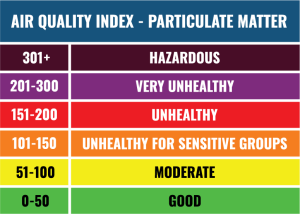
10 Easy Hacks to Transform Your Home’s Air Quality and Breathe Fresh Again!
Are you tired of constantly feeling suffocated by pollutants and contaminants lingering in your living space? Well, fret no more! In this article, we’re unveiling 10 mind-blowing hacks that will revolutionize the way you tackle poor air quality in your home.
Several years ago we lived in Bangkok, Thailand. I loved it and felt like I was in a dream every day. What I did not love, was the air quality which hovered between red and purple every day. Here is how it’s measured.

Now, surprisingly the air quality in the Northeast U.S. is beginning to replicate what we experienced in Thailand. Do you also find yourself sneezing more or suffering with runny burning eyes? Dealing with this outside is one thing but why tolerate it in your home?
There are several steps you can take to counteract it. Here are some effective measures you can implement:
1. Identify pollution sources: Determine the sources of air pollutants in your home. Common culprits include tobacco smoke, household cleaning products, pet dander, mold, volatile organic compounds (VOCs) from furniture and building materials, and outdoor pollutants entering through open doors and windows.
2. Ventilation: Ensure proper ventilation in your home. Open windows and doors when outdoor air quality is good, and use exhaust fans in areas prone to high moisture, such as kitchens and bathrooms.
3. Regular cleaning: Maintain cleanliness in your home to reduce dust, allergens, and pollutants. Vacuum carpets and rugs frequently using a vacuum cleaner with a HEPA filter. Dust surfaces regularly with a damp cloth and mop hard floors.
4. Air purifiers: Consider using high-quality air purifiers with HEPA filters. These devices can effectively capture and remove fine particles, allergens, and some volatile organic compounds from the air.
5. Indoor plants: Incorporate indoor plants that have air-purifying qualities, such as spider plants, peace lilies, or snake plants. These plants can help remove certain toxins and improve air quality naturally.
6. Control humidity: Maintain appropriate humidity levels in your home, ideally between 30% and 50%. Use dehumidifiers in damp areas to prevent mold growth, and use humidifiers during dry seasons to add moisture to the air. Regularly clean and maintain these devices to prevent the growth of bacteria or mold within them.
7. Avoid smoking indoors: If anyone smokes in your household, encourage them to smoke outside. Cigarette smoke is a major contributor to poor indoor air quality.
8. Proper storage of chemicals: Store household chemicals, including cleaning products, paints, and pesticides, in a well-ventilated area away from living spaces. Ensure containers are tightly sealed to prevent chemical vapors from escaping.
9. Test for radon and carbon monoxide: Regularly check for radon and carbon monoxide levels in your home. These gases can be dangerous and negatively impact air quality. Install detectors and seek professional help if necessary.
10. Regular maintenance: Schedule regular maintenance for your heating, ventilation, and air conditioning (HVAC) system. Clean or replace filters as recommended by the manufacturer and ensure the system is operating efficiently.
Remember, improving indoor air quality is an ongoing process. By implementing these measures, you can significantly reduce pollutants and create a healthier environment in your home. If you have specific concerns or health issues, it is advisable to consult with a professional such as an HVAC technician or an indoor air quality expert.



